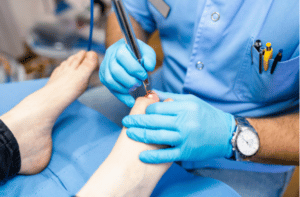 Ingrown toenails can be a nuisance. The pain can cause you to miss out on a lot as you try and nurse your aching foot. Chronic ingrown toenails can add to the frustration. With the help of dedicated professionals, you can be on your way to finally end ingrown toenails.
Ingrown toenails can be a nuisance. The pain can cause you to miss out on a lot as you try and nurse your aching foot. Chronic ingrown toenails can add to the frustration. With the help of dedicated professionals, you can be on your way to finally end ingrown toenails.
What Causes Ingrown Toenails?
Ingrown toenails are no fun, and it can be infuriating when they return. This problem raises the question of what causes ingrown toenails.
Many factors contribute to developing ingrown toenails. A common reason is improper cutting techniques that round off the toenail.
Also, cutting the toenail too short can create ingrown toenails. When this happens, skin grows over the corners of the nail. If skin covers the corners of the cut nail, it regrows inside of soft skin, creating an ingrown toenail.
Other causes of ingrown toenails include:
- Poorly fitting shoes
- Repeated foot injuries
- Poor foot hygiene
- Genetics
Long-Term Effects of Ingrown Toenails
If left untreated, an ingrown toenail can cause more than just a bad day—it can lead to serious, painful complications:
-
Open sores and ulcers: Constant irritation and broken skin can lead to ulcers that simply won’t heal on their own.
-
Infection that spreads: A minor ingrown toenail can escalate into a deep bacterial or even bone infection.
-
Tissue decay or necrosis: Severe infection may cause tissue to die—yikes, and potentially amputation in extreme cases.
-
Compromised blood flow: Persistent issues can disrupt circulation and nerve function in the toe and foot.
Analogy: It’s like letting a small crack in your windshield go untreated -the damage can spread and become dangerous. Better to fix it early, right?
How Ingrown Toenails Affect Everyday Activity
Even before it escalates, an ingrown toenail can throw off your daily groove:
-
Pain with every step: Simple things like walking, standing, or wearing shoes can feel like walking on broken glass.
-
Swelling and inflammation: Your toe might swell so much that even putting on flip-flops feels like a wrestling match.
-
Reduced mobility: It can sideline your exercise, errands, or just make commuting uncomfortable.
-
Distraction: The constant throbbing can throw off your concentration…at work, school, or bedtime.
It’s like having a pebble in every shoe – tiny but irritating until it’s fixed.
Can Ingrown Toenails Heal Themselves?
It might be tempting to wait a while and hope an Ingrown toenail goes away, but taking action is critical for healing.
When caught early enough, many ingrown toenails can be treated at home and eventually heal. Soaking your feet in warm water several times a day can help relieve the discomfort you feel.
Next, place waxed dental floss under the ingrown area. The floss helps to encourage the nail to grow back in its proper place.
Also, take over-the-counter pain medications to help with any discomfort you feel.
These methods and managing pain can help with mild ingrown toenail cases.
Is Treatment Typically Covered by Insurance?
Yes, ingrown toenail treatment is generally covered by insurance with some caveats:
-
If treatment is deemed medically necessary—like when pain or infection is present—insurance typically covers it. Medicare Part B often covers in-office procedures for medically necessary cases.
-
Major insurers such as Aetna or Anthem often cover surgical ingrown toenail removal when medically necessary, not as routine care.
-
Bottom line: If you need to see a podiatrist and the issue is more than cosmetic, coverage is likely…though always check your plan or call our office to verify.
How Long Does It Take to Heal?
Healing times vary based on severity:
-
At-home care (mild cases): Soaking, gentle lifting, and proper trimming may ease symptoms in 7–14 days, with full healing in 2–4 weeks.
-
Minor procedure (partial nail removal): After a podiatrist treats it, you’ll likely resume normal activities within a few days—though the nail itself may take 2–4 months to regrow.
-
Surgical matrixectomy (to prevent recurrence): Surgical sites typically heal in 4–6 weeks, depending on your care and whether an infection was present.
When to See A Doctor
Conservative methods of treatment may help for a while. But sometimes, a more aggressive approach is needed to treat more severe cases. Discoloration around the area, infection, or intense pain can mean trouble, and it’s time to seek an expert.
If you experience worsening symptoms, Foot and Ankle Clinics of Utah can help you handle nail problems and help restore your quality of life.
If you want to learn about our treatment options, schedule a consultation with any of our 4 locations.
Call us today at 888-467-1926 (American Fork), 888-462-0422 (Payson, Orem), or 888-464-7317 (Springville).
